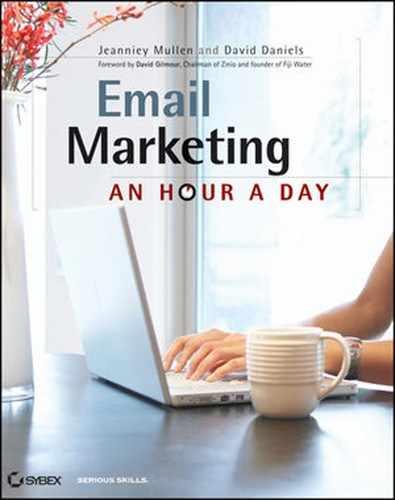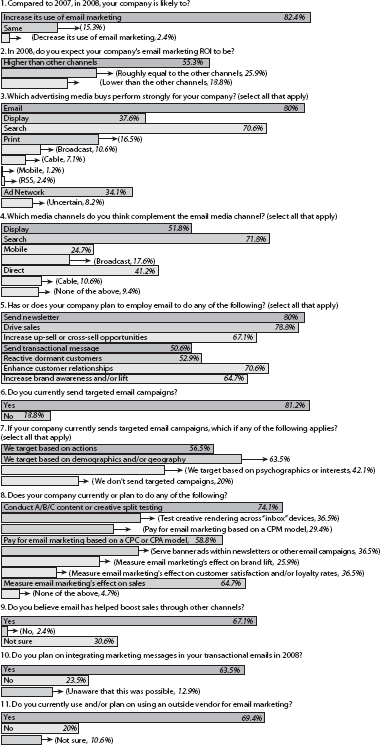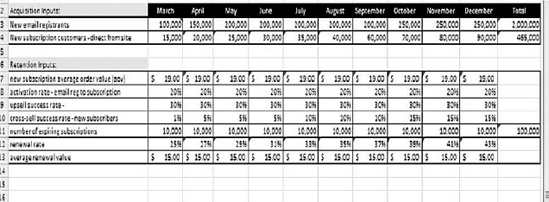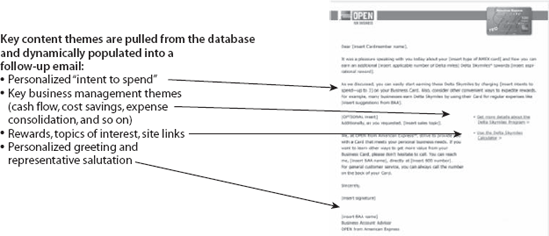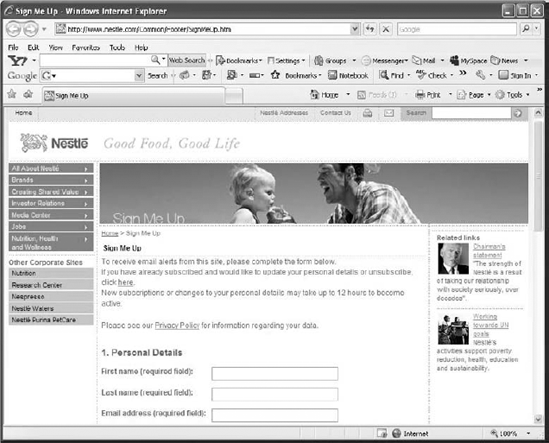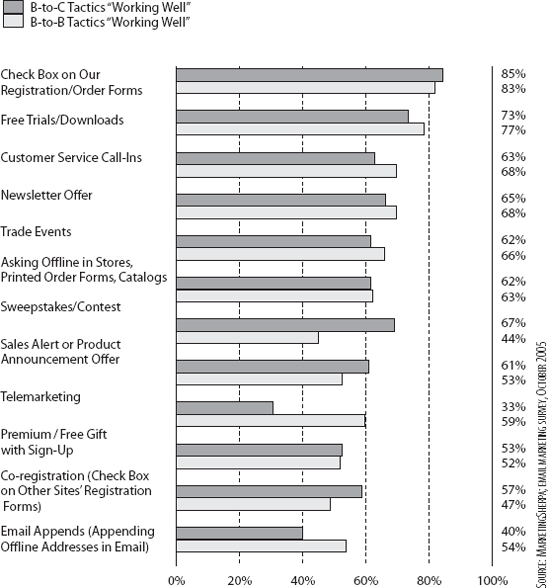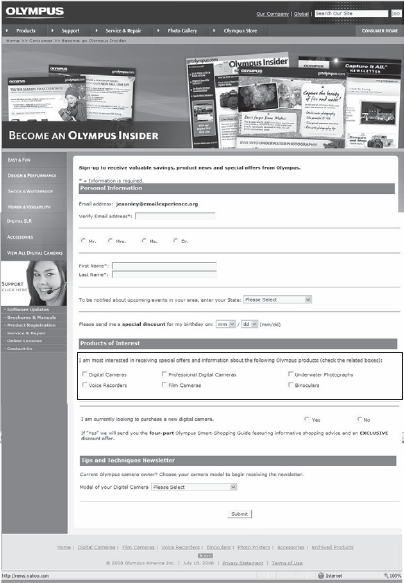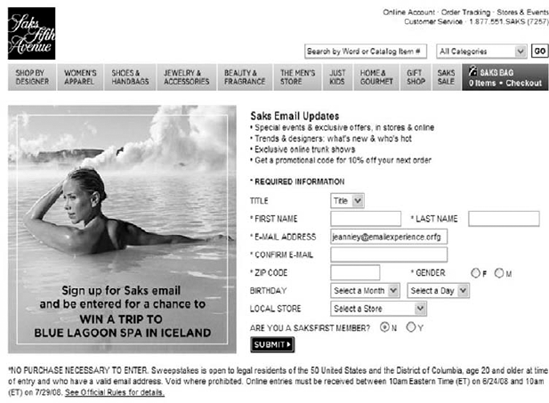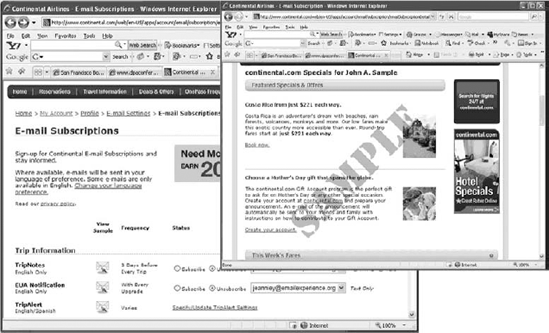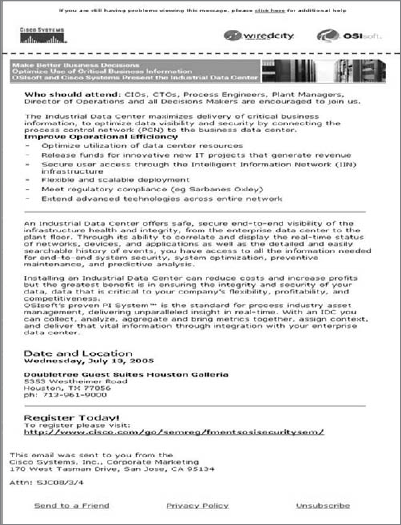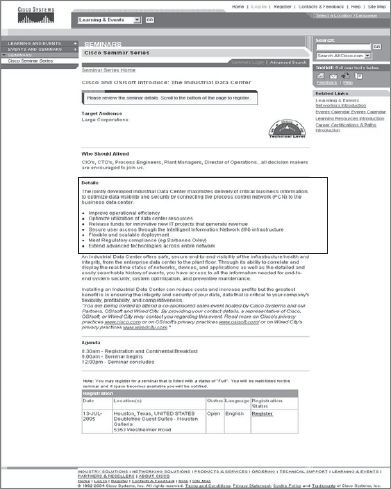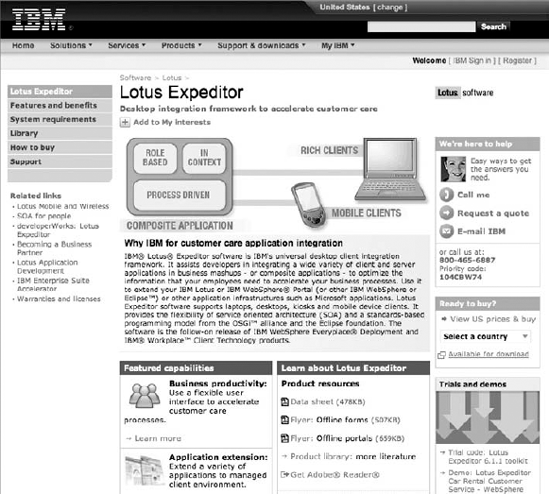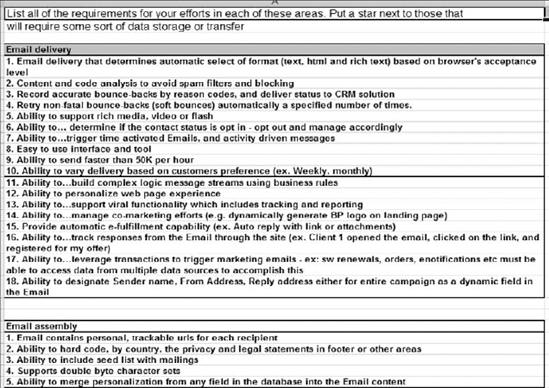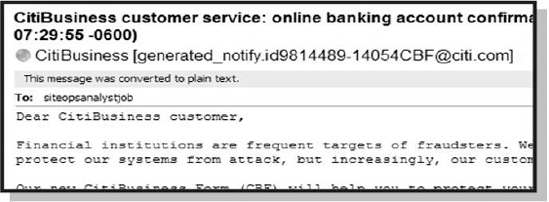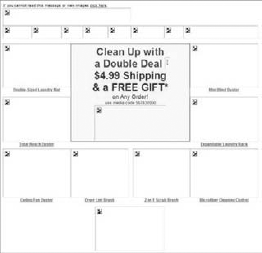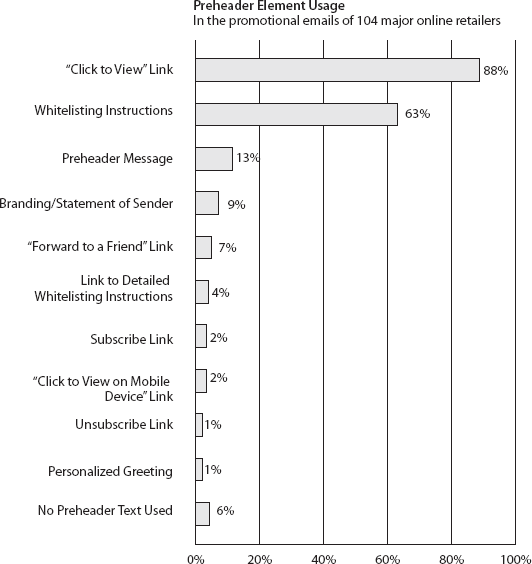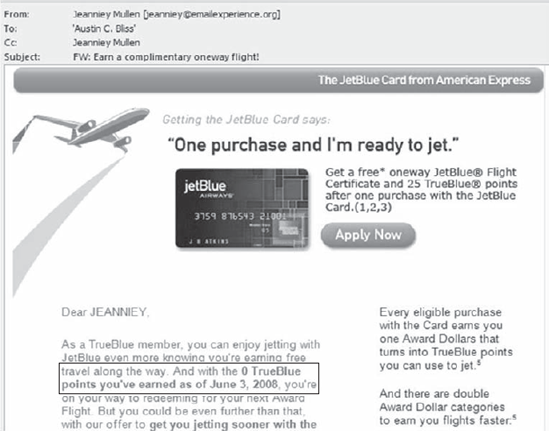Now is the time to kick off the most fun, frustrating, and rewarding experience you can have: creating your email campaign. This chapter and the next three form a calendar, guiding you through the details that will make you the best at your newfound craft. In this first month, you will lay the foundation for your campaign efforts. These are the most critical areas to build in the right way, because they will drive the success of anything else you do in your email campaign.
Chapter Contents
Week 1: Preparing Your Resource Arsenal
Week 2: Building the Blueprint for Success
Week 3: Counting Down to "Go Time"
Week 4: Testing Your Way to the First Campaign
An email campaign, like anything you do in life, is much easier when you are prepared. To begin building your email campaign, you want to have at hand all the resources and ingredients you will need. You should have a number of items ready to access as you dive into the strategy and content creation.
Over the years, the best way we have found to manage this process effectively is to create a comprehensive resource arsenal, which includes at a minimum the following items:
- Checklists
Many kinds of checklists exist: general, strategic, creative, technical, and assessment. See Appendix B for some of our favorite checklists created by the Email Experience Council.
- Technology
These include the hardware and software (onsite or via an ESP) for delivery, database, analysis, and best practice validation. See Chapter 5 for details.
- Research
Make sure you are armed with historical and benchmarking statistics, trends, compliance-related information and insights, and even competitive knowledge.
- Creative
Creative checklists include lists of what your competitors are doing, including sending frequency, their creative design, best practices for templates (which are covered in Chapter 7), and the best strategies for designing for people who are reading emails on the go (these are discussed in Chapter 8).
- Strategy Resource Sites and Blogs
These can keep you up-to-date on the latest research, give you fodder regarding a best practices debate, or even give you an outlet to ask an expert a question or two. See Appendix A for some of our favorite sites.
- Case Studies
Throughout the book you'll find case studies that enable you to learn firsthand from the experience of others about what works and what could be done better.
The focus of this week is to gather all the elements needed for your resource arsenal and then build the argument to get those elements funded that have an associated cost. Each day, you can spend one hour on a critical initiative that will send you on a trip to the bank Friday afternoon with that signed check:
Monday: Getting smart
Tuesday: Evaluating tools and resources
Wednesday: Budgeting
Thursday: Related marketing initiatives
Friday: Getting the boss to sign the check
Note
Write This Down: It is estimated that more than 500,000 individuals per week access "self-help" websites and online resources relating to email campaign design, development, and execution.
Googling email marketing help generates hundreds of results pertaining to where people can piece together guidance. The challenge with this is, Who has time to sort through all those entries?
Searching for help when you are in a panicked or rushed mode will make you frustrated. Many times, the authors of this book have actually sifted through a number of these web pages only to find statistics that are undated, outdated, or even inaccurate. This is not the type of experience you need when beginning your emailing efforts.
Getting smart about email marketing doesn't mean knowing all the answers. It means knowing what makes email marketing work and what type of resources you need to build something effective. A rule known as the chunking principle states that the mind can retain no more than seven items of information without memory loss. Because we want you to retain most of what you read, we have decided to condense what you need to know about email marketing into seven key truths. These are facts you should post on a wall somewhere. As you delve into email marketing, you will be challenged to remember these truths. So please, use today's hour wisely and keep this section handy.
Omniture reports that more than 21 trillion emails were sent in the United States in 2007. These were, by no means, all marketing-based messages. One of the key truths about email you need to retain is that email marketing is just one small facet of a standard person's "email life". People use email today for many purposes, both personal and business. In many cases, the use of email is less about reading marketing messages and more about the improved facilitation of life.
And let's just put the argument to bed right now that only people of a certain age use email—it is just not true. In 2007, eMarketer surveyed the use of online access by various age ranges, and Table 6.1 shows the results.
Table 6.1. Selected Weekly Online Activities of U.S. Internet Users, by Age
Millennials (13–24) | Generation X (25–41) | Baby Boomers (42–60) | Matures (61–75) | |
|---|---|---|---|---|
Watching and reading personal content created by others | 71% | 56% | 40% | 36% |
Reading and posting on message boards | 51% | 43% | 29% | 22% |
Socializing | 62% | 41% | 25% | 18% |
Participating in a discussion forum | 34% | 33% | 24% | 19% |
Although this table doesn't specifically isolate email usage, it does demonstrate that people, of any age, go online to communicate and connect about personal elements of their lives.
So when you think about email, you must not think about it in the context of a campaign or a single effort, or even as marketing. You must think about it as an extension of personal and life-related communications. This will ensure that your design efforts consistently create a strong brand impact and a sense of personalized loyalty and interest among your readers.
This is one truth that will help you maintain an edge over your competition. Think about it: When email marketing first started, the world was a different place. Email marketing was new, list growth was simple, spam was a type of meat, and the best practices written at the time did a great job of covering what to do in that environment. By about four years ago, the volume of spam changed best practices in our industry, and the CAN-SPAM legislation discussed in Chapter 5 was enacted in response to email's evolution. Best practices changed for creative, list growth, and delivery. Even as recently as early 2008, changes in the way that email unsubscribes are handled were introduced to ensure that the perception of email marketing remains positive.
What this means to you is that you must always look at the dates of research, case studies, and best practices and hold them up to the standards of the current day's trends.
Even today, there is still a perception that email marketing is one channel, mobile marketing a second, RSS a third, and even social networking a fourth. In these instances, many companies treat these as separate marketing channels. In today's online world, it is becoming increasingly difficult to keep these channels separate because they each act as drivers to the other.
Well, we have news for you! Any message sent electronically is considered email marketing.
Why is this a truth you need to know? It's because the lines among these types of messaging channels will continue to blur as time goes on, and soon the world will rely on "personal messaging" regardless of the location or the device. These media are all driven through Internet channels and require permission and selection of message interests/types. This means everything you are thinking about for email will also become critical to future messaging strategies for your company. As the famous philosopher Yoda once said, "Choose wisely you must."
We recently heard a speaker at an email conference ask the audience this question: "Who here invests in increasing the delivery rate of their emails?" Almost 90 percent of the hands went up. He then asked another question: "Who here spends money to acquire new customers?" Again, 90 percent of the hands went up. And then he asked this: "Who here builds programs to monitor and target those people who provide you their email address but never respond to an email you send versus just removing them from your list after a certain time?"
After the crickets stopped chirping, he went on to explain that his company's research has indicated that less than 50 percent of a list will ever respond to email campaigns. And research that Jeanniey has done shows that even if someone on your list is not responsive, once they have provided an email address, they will purchase 150 percent more than those who shop at your company but do not opt in.
This means your list value has expanded. It is worth more than just the opens and clicks it drives. You should always plan to evaluate the purchase or response power that people on your list provide through all channels to identify their value.
Remember that grade-school song? The last line is, "The cheese stands alone." That's not a smart attitude for email marketing. Many people in marketing assume that email marketing is similar to the "cheese" in this song—a stand-alone messaging channel that drives revenue and strengthens relationships. The truth is, elements of email marketing live in every aspect of our messaging world. Forms sit on websites, capture points happen both online and offline, banners drive to landing pages with forms, and searches drive to deep pages that encourage engagement.
If email stood alone, none of these would be relevant. But for successful email marketing, you cannot afford not to think about all the touch points of your email marketing campaign.
In the Chapter 3 analysis of email marketing technology, you saw that vendors can be tremendously helpful partners. That said, it has often been our experience that technology partners can easily slip into a "don't ask, don't tell" mentality. Many times, these partners wait for you to ask for a service, feature, or support effort before they provide it to you. The problem with that is that if you don't know what you are missing, you don't know what to request. It is for this reason that we encourage you to read the case studies on technology partners' sites—not just your own technology partner but the top ten technology partners. By doing so, you will be able to see, in context, what types of services and features you should and could be getting out of your partner.
Don't allow the money you spend in this area to provide you with just the basics. Push for ultimate service and support.
Someone once told us that you learn more from your mistakes in email than you do from your successes. In most cases, the best mistakes you make are not planned. When you don't have productive mistakes to learn from, ignoring the rules and trying something crazy to see how it flies can work pretty well, too. We certainly don't mean to imply that you should ignore the law. You definitely shouldn't. But, you should think of new ways to share emails and try them with a sample of your database. Some of the most successful "rule-breaking campaigns" of the past have included the following:
Creating an email that scrolls sideways
Sharing an "unsubscribe" confirmation landing page that offers ways to opt back in
Posting a call to opt in at the end of a video on YouTube
Sending an email with a blank subject line
Now that you know the seven truths of email, you can use them to evaluate your tools and resources.
On this second day, we are going to continue having fun by getting all our tools and resources together. Whether this is your first time creating an email marketing plan or you are a veteran, you have our guarantee that you will take away something useful from this section.
A sound email strategy presents new opportunities for overall business improvement by putting into place tools and processes that can solve current performance problems and open new avenues to bolster sales and customer satisfaction.
Before selecting or even evaluating new technology solutions, an organization should start by determining the overall objective and scope of their email program, then identifying current problems and obstacles to meeting this objective, and finally creating an inventory of current resources. Once a company has a clear understanding of what it wants to achieve, what's keeping it from getting there, and what is already in place, then it can develop an evaluation and selection plan to find the solution and define the processes to fulfill its email strategy. You can use our handy quiz to help determine what your areas of focus should be.
Understanding what to do with your emails can be challenging. You will find that by answering a few questions and thinking through a strategy, you can move light-years ahead. This quiz should take only a few minutes of your time:
My job is solely email marketing to an existing house list.
Yes
No
I don't know
I work for a company that has:
More than 100 employees
15–99 employees
Fewer than 14 employees
The role of the emails I send needs to be:
To drive high open and click rates, and possibly purchases or leads.
Multipurpose: sell, retain, provide service, and more.
Every email I send needs to make money for my company.
I can build specific landing pages to support email or email address capture.
No, my company uses one landing page for all media.
Yep, sure—the more, the better.
If they are premade, or free, yes; otherwise, no.
My email database is the company database.
No, we have a CRM solution.
Yes.
You mean my email service provider can be my database?
How much of a budget do you have to invest in email technology or resources?
More than $100,000 annually (or $.01 per email sent on average)
$25,000–$100,000 (or $.005 per email sent on average)
As little as possible, but as much as is needed to make emails work
- Answer key:
Give yourself 5 points for every "a" answer you selected.
Give yourself 2 points for every "b" answer you selected.
Give yourself 0 points for every "c" answer you selected.
- 0–11 points:
"Down and Dirty": You are a marketer with one focus: get it done profitably or else. In the list in the next section, you should look for technologies or services with one asterisk (*) next to them.
- 12–20 points:
"Workin' It": With some investment dollars, you are a shrewd marketer who has many priorities and who needs technology that supports a multichannel mix with minimal excess expense. In the list in the next section, look for technologies or services with one or two asterisks (**) next to them.
- 20 points or more:
"Fit and Fabulous": Your high-visibility company requires that each role in your organization remain focused on key aspects of communication that create the ultimate experience. That said, you need to remain within the boundaries of your group's efforts when implementing programs to ensure a common voice and brand is maintained. In the list in the next section, look for technologies or services with one (*), two (**), or three asterisks (***) next to them.
Once you have determined the focus you have for your email programs and the goals you want to accomplish, you can effectively begin to evaluate which technology will best support your efforts.
Now would be a good time to revisit Chapter 2 to gain some key insights on email delivery providers. Keep in mind, though, that delivery services are not the only technology out there. Listed next are the different types of email resources (outside of email service providers) you will want to review. You'll find contact information for all the vendors in each category in Appendix A.
- Statistics and best practices:
Email Experience Council's Whitepaper Room**
Center for Media Research*
MarketingCharts*
EmailStatCenter*
MarketingSherpa**
JupiterResearch***
Forrester Research***
eMarketer***
- Email-specific design or design analysis:
Smith-Harmon**
MailChimp*
Bunnyfoot**
Eyetools*
- Deliverability:
Iconix*
Habeas**
Return Path**
Pivotal Veracity**
Lyris*
- Analytics and testing:
Omniture
WebTrends
Coremetrics
- Email list growth:
Datran Media**
Yesmail**
For each of these areas, you will need to begin doing research to see which vendors to review. We suggest you keep them all in your back pocket. You will be surprised to see how they will come in handy down the road.
Drafting an email marketing budget can be a daunting task. It seems oddly simple in the beginning, but it quickly becomes riddled with complexities and challenges.
To begin with, you should make a list of every type of expense you think you may need. (Yes, if you haven't noticed already, planning for email marketing requires lots of lists.) There is a lot of research out there that will help you justify the budget you're proposing for email, including the recent survey results from Datran Media, as illustrated in Figure 6.1.
Once you've demonstrated to management the benefits of email marketing, what you need to focus on is making sure you have the money to account for all the email costs. In Chapter 4, we listed all the types of costs you should consider, including the following:
List replacement fees
Design
Testing
Data support
Mad money
To take these costs one step further, we recommend building a cohesive email marketing plan that also takes these factors into consideration:
Training costs, conference fees, and more. It is always a wise investment to earmark some funds (no more than $2,500 per year) to attend conferences or purchase email intelligence. If you are a small company, this may seem like a large investment, but the dividends are phenomenal. The networking alone at email-specific events will provide months and years of higher return on investment.
Technical design resources. In an earlier section, we mentioned including funds for technical support with your email vendor, but sometimes you will need to pay an outside company to design and test Flash, animation, video, or other new components.
Mobile messaging and RSS integration tests. Although these may appear to fall outside your budget or realm of responsibility, they really don't. Planning for a mobile test with email is going to be the cornerstone to future email marketing strategies.
Preference center design. This was introduced briefly in Chapter 2 and will be covered in more detail later in this chapter and in Chapter 8 (which looks at preference centers for the mobile channel). But for now, what you need to know is that designing a preference center can become a costly initiative and will need its own budget line.
Once you have your line items listed and associated costs of doing business identified, the next step to take today is to build an ROI calculator. Using this tool, you can calculate the expected response rate for each email sent and how many emails need to be sent in order to drive the return on investment. Some people choose to build these to determine what type of response rates they need to justify the cost. Others build them to determine how much they can spend based on the projected ROI. Either case is fine. Just make sure you build one. It should look something like the example shown in Figure 6.2. (The data were created for presentation purposes only and do not reflect any company's actual budget or business plan.) It should be a living document that you update and manipulate weekly at a minimum.
You are now locked and loaded with knowledge about the email marketing space. You have a list of the types of services and technologies you can leverage and will need a budget (including an ROI forecasting document) in place as well as. What's next?
Remember the third truth from Monday's focus: Anything you do in the world of marketing has an email component. Regardless of whether you work for a large or small company, and whether your job is focused only on email or includes broader efforts, email will impact almost everything your company does. Today, your job is to review every aspect of marketing or advertising that your company may be doing and to see where and how email could or should be making an impact.
This is probably one of email marketing's most fun activities because it is very visual. By creating an email "look book," you will be able to effectively determine whether you need to make any changes to your budget to support other programs, design additional creative, or develop tests to supplement what you have noted.
You will also be surprised by your findings. Recent studies have shown that branding in email creative is consistent across all communications for only about 5 percent of companies. This is natural for large companies that work with multiple agencies. It is also expected for very small companies that implement efforts over time, as their services grow, often leaving older branding elements in play because of lack of resources or a volume demand to change it. So, where should you start?
The first place to look is at your print advertising. If your company is doing a print campaign, your creative may look something like the Sephora ad shown in Figure 6.3.
This print campaign is built specifically to ask people to opt in to an email effort. If your advertising group is doing something like this, good for them! But, do you know what type of email is being sent once someone opts in? Or even what is happening to the name once it is in your database? If not, you should definitely find out. Also note that addresses coming in from a print experience deserve an email welcome message that references the source.
The second element to check is your customer service center. Once someone is live on the phone, is your representative asking for email address permission? Is there a workflow built to drive these customers to receive the right follow-up email or send them the most appropriate branding information? In Figure 6.4, American Express integrates the right brand with dynamic messaging, which is passed along to the email team to continue the messaging appropriately.
If advertising and customer service have matters under control, move along to examine your corporate site. These sites often post research, press releases, and news coverage, which a visitor can share with a friend or colleague. That is fantastic news, as long as it is consistent with your efforts. Many companies fall short in this area because their pages ask to capture email addresses but then do nothing with them.
Figure 6.5 is an example from Nestle that shows the investor relations opt-in box. It does a good job of capturing profile information, but is it linked to other types of emails, or even using space inside the emails to promote the benefits of opt-in with other Nestle products? It is not.
Finally, the last large area you will want to review is your online media planning efforts. If you are a business-to-business company, your focus is on driving leads. Here is a great example of a banner that offers a free trial:

Once again, it is your job to determine what happens to the email address once someone provides it for the download.
The impact of other marketing efforts on email grows constantly. Your job as an email marketer is twofold: to create the best email programs you can and to optimize them as you go. But it's also to ensure that any email marketing opportunities that arise thanks to your company's efforts are managed and effectively utilized in a way that creates the most positive brand experience around.
For each of these areas, ask yourself these questions:
Is there a chance an email address can be collected?
Is there a chance an email message will be sent?
Where does this data go?
What kind of messaging is sent?
Can I use this person's data in the future for my program, and if so, how?
These questions will help you build a valuable resource for collecting new and highly active email addresses when you are looking for ways to increase your database size.
It's D-day. You have spent the week researching what you need to know about email and what technologies and services you think will be of the most help to you. You've estimated the costs associated with your intended efforts, and you have identified areas of your website that will add value to your current programs. The meeting with the boss is set, and all you need to do is get the check signed.
Whether you are asking for $50 or $5,000 or $500,000, asking your boss for money to support your email marketing programs is going to require some discussion about the value of the email program to the company overall. We hope that by now you have picked up a few of the key highlights from earlier chapters in this book. These include the following:
Email is more valuable to you than just one-time sales; email address opt-in is an indicator of high-value customers.
Email marketing happens in every area of the company; it is a critical branding element.
Email marketing saves significant dollars; sending an email saves more than 90 percent compared to postal mail.
To help support these facts and enable C-level executives to understand the value of supporting email marketing, the Email Experience Council created a report outlining the value of email addresses to a company, shown in Figure 6.6. Use these elements to help develop your plan of attack when you speak with your boss.
Note
You can download a copy of the ValueofEmailAddress.xls calculator from this book's web page at www.sybex.com/go/emailmarketinghouraday.
Your goal in this communication is to demonstrate the holistic power of email in the areas listed earlier. We urge you to stay away from tactical elements such as open rates and even click-through rates.
Note
Write This Down: Nearly three-quarters of email marketers said in a recent survey that they plan to spend either the same amount or more on email marketing in 2008 as they did last year, according to the 2008 "E-Mail 2008: Top 10 Research Findings and Practical Ways to Increase E-Mail Performance" report. (Source: MarketingSherpa)
Once the ink on the check for your email marketing program dries, it is time to get down to business. During the second week, your focus will be on designing the core plans and validating the destinations for your efforts. This can be either data related or creative driven. Skipping any section in this week can set your program efforts back significantly, and as you will see, there are many examples of ways you can approach these topics. Of course, the examples are being shown to illustrate concepts and will need to be customized to your company's specific needs and goals. There is no one-size-fits-all in email. So if you are ready, get your pen and paper, and get ready for this week's events.
Monday: Evaluating your current house file and file size needs
Tuesday: Creating the acquisition plans
Wednesday: Focusing on the opt-in process and customer preference centers
Thursday: Reviewing the opt-out process
Friday: Making sure your landing pages are a good place to land
We have a friend who works at the Heinz factory in Pittsburgh, Pennsylvania. Her job is to schedule the delivery of Heinz products to grocery stores in the Midwest. It is a really challenging job because it has to take into consideration all of the following factors:
Based on sales of products and prior-year trends, when is the current shipment expected to run out?
How much does the new shipment need to contain in order to maximize pricing and delivery timing?
What will the contingency plan be if/when a grocer calls with an emergency order they need filled within 12 hours (especially if the truck needs to get to a dock and be loaded)?
What is the plan if the store is unable to sell the items because of a drastic change in the weather, the economy, or other uncontrollable occurrences?
How is she able to organize and manage all these elements dynamically and ensure there is no excess or lack of product? Somehow she is able to effectively create a process and workflow that allows her to forecast and manage to change.
When you think about it, we have the same need in our profession. Somehow, you need to effectively forecast the amount of interaction and turnover the names in your email databases will generate so that you can budget and plan for list growth initiatives at the right times and achieve optimal results. You have to do this without going over budget or losing valuable ground.
In 2006, Silverpop conducted a list growth survey of 321 marketers. As reported by Direct magazine, it found that when asked to name their list growth tactics, almost two-thirds of the email marketers surveyed cited offline advertising and direct marketing. More than half mentioned trade shows or online marketing and web searches. Viral marketing was third. The study also revealed a gap between planned list-building tactics and those seen as successful. For example, 24 percent intend to use viral marketing, but only 10 percent see it as successful.
These are interesting insights, but before you can get into worrying about how to grow you list, you need to evaluate how effective your list is.
Note
Write This Down: The average size of an email marketing database ranges from 20 to 60 percent of the total marketing database. (Source: Email Experience Council)
How big is your file compared to your company's total marketing database? Knowing this will help determine the total impact your current file can ultimately have. For example, if your file size is less than 20 percent of your entire marketing database, you will need to ensure that it is the most responsive list ever or build in some serious plans to grow the file. In this case, growth through service emails or call centers would be the likely starting ground.
How old is the data on your database? It's sad to say that even with the most responsive lists, email addresses that have been on your file for more than three years tend to not respond nearly as well as newly acquired email addresses. If you have an old file, you may very well want your starting technique to be in the areas on your website where you can attract some "fresh blood."
What is the average annual purchase of a person on your email list compared to names not on your list? Although Forrester data indicates that the average person who opts in to your emails will purchase 138 percent more than someone who does not provide you with an opt-in email address, you should check the validity of this with your list. If your list of email opt-ins is not performing at the same rate as your offline list, your starting point may need to be the source of your email opt-in capture.
These three elements will get you well on your way to answering some critical questions not only about how large your list is but also about its effectiveness. Once you have this information, you will be in a good position to compare the size and response to your budget numbers, discussed in the previous section. This exercise will give you a clear indicator of how much you need to grow and what the starting points should be.
Staying on track with list growth is an important factor to focus on. Many times, we have seen people put the best plans into place and then have them fall through as soon as THEY LOSE THEIR FOCUS. Without your list, you will not be able to market. Don't lose sight of that.
Now that you know how much you need to grow and have some indication of where you may need to start, it is time to put together the plan for growing your acquisition efforts. You will have a number of choices to make. Based on your budget and your time, and results of tests, your plan can be expected to change and develop over time. We strongly encourage you to launch your acquisition plans slowly over time. Test not only for the effectiveness of meeting name-capturing goals but also for the results these new names have for your company. Do they perform in the first 30 days? Are they still effective 90 days after adding them to the list? Are there high spam or complaint rates? All these elements are factors in determining what type of list growth efforts and acquisition plans will work best for you.
An Intelliseek survey by Forrester Research on U.S. consumers' trust or distrust by type of advertising found that roughly two-thirds of respondents said they trusted emails they signed up for. This confirms what many industry experts have known all along. Email marketing is a powerful relationship-building tool. So, how does an organization implement a successful email loyalty program?
According to a study on worldwide email messaging by the market research firm IDC, daily email traffic is now estimated at message sent after 60 billion. Without question, the easiest way to find relevant email addresses is to ask every consumer who visits your website for theirs. It's simple enough, but most sites do not generate enough online traffic to drive a high volume of opt-ins. And without a sufficient volume of site traffic to capture elusive opt-in addresses to drive strong relationships between buyer and seller; business owners will lose valuable market share faster than it takes the deliverability status on an unsolicited email to bounce. So, what can you do to generate site traffic?
The answer: channel surf. Start by using as many channels as possible to drive online interests and grow a company database. A marketer's push and pull tactics can range from one, many, or all of the following channels to help create a steady flow of site traffic:
Keyword buys
In-store point-of-sale displays
Trade shows
List rental
Viral and cross promotion
Co-registration
Call center
Direct mail
Customer care
Product warranty registration
Co-marketing
Partnership/third-party channels
The data in Figure 6.7 illustrate different inbound channels available to online marketers and how effective each channel is at generating opt-ins.
List acquisition doesn't need to be expensive. It can work very effectively given the right focus. However, we do recommend you never put more than 15 percent of your list growth strategy into one effort. This could cause serious issues and repercussions should something go wrong.
Assuming your strategy of "reaching out" to use as many channels as possible to generate a steady flow of site traffic is successful, what next? The next step, and probably the most important in your effort, is to generate responsive and long-term opt-in permission approval.
This requires a focus on the best practices of today (remember, we said you need to watch these all of the time) to develop the best customer experience.
To make it easy on you, we asked Cliff Seltzer of PureSend to craft the following list of the current best practices in opt-in and preference centers; Cliff also provided the phenomenal creative examples. Use this as a "tear me out" checklist to keep next to the email marketing truths, and you will always have something you will find useful in design and strategy meetings:
A prominent call to opt-in on all home and landing pages. A survey by JupiterResearch on how U.S. marketing executives capture consumer addresses found that 60 percent of all opt-ins came from the online registration process.
Non-obtrusive link to all policies. Links that enable readers to access the "about us" section and terms and conditions often engender a sense of trust.
Frequency options. Giving your readers the ability to receive information more or less frequently can reduce unsubscribes up to 25 percent.
Sample content. Sharing an example of what your email will look like helps set expectations.
Multichannel options (SMS, print, PDA). Offering readers the ability to sign up for your information through a variety of ways gives readers a sense of control.
Content-type format (HTML/text/PDA). This is a new trend, which you will read more about in Chapter 8.
Lots of content customization options. The most successful email programs offer the ability to personalize messages (see the Petco example in Chapter 2).
Easy unsubscribe. Based on updated CAN-SPAM laws, a one-click opt-out is critical.
Short and long registration options. The email address is the only item that is truly required; many users will start at this level until you've earned their trust.
In fact, a recent MarketingSherpa study on how to get more opt-ins found that 88 percent of users say they are willing to spend time answering questions about their tastes and interests online, and 25 percent said they would spend more than six minutes filling out an online registration form.
Clear expectations. Set expectations on what will be delivered.
Reasons for subscribing. Spell out the reasons the person should be subscribing.
Trust certificates. Provide trust certificates somewhere on the page.
Delivery times. Request specific delivery time, with time zones. This is a tough one for many ESPs who can't get email out fast enough to promise a specific time, so you may think of it as a future goal.
Figures 6.8 and 6.9 illustrate opt-in interfaces from Olympus and Saks Fifth Avenue.
Another example is from Continental Airlines, which has always followed best practices in its opt-in strategy. Here are Continental's most important advantages:
It has preference centers. Early on, Continental established best practices in preference centers. Figure 6.10 shows an example.
It takes chances. Continental was an early adopter of RSS and mobile messaging. We had the chance to work with Continental a few years ago and were impressed by its willingness to look toward the future.
Its welcome messages speak to the consumer. Many of Continental's frequent flyers have been impressed with the way the airline creates messaging that will help make flight planning and execution easier. Continental was among the first airlines to use email to alert customers to check in online and provide service updates via email mobile messaging. These transactional messages aren't viewed as interruptive at all. They're appreciated.
Setting up a plan for email acquisition, although it's essential, is only as effective as the opt-in methodology that is used. Once someone opts in, both best practices and CAN-SPAM say you must provide a simple, clear, one-click way to opt out. In reviewing your company's opt-out process, the first question you want to ask yourself is, "How well are we currently handling opt-outs?" As with the exercise to determine which elements of your advertising marketing program/website currently support an email conversation, this is also a good place to start gauging the effectiveness of your opt-out process.
In 2008, eROI, an integrated marketing service company, conducted an analysis of how companies are enabling people to opt in and opt out. Their findings contain insights you need to know when beginning to design your opt-out strategy.
A summary of their findings indicates that less than half of marketers used a confirmation process to validate opt-in requests. The difference between getting an opt-in approval and getting a confirmed opt-in can create significant differences in response rates for future emails.
To entice subscribers, 88 percent of companies reported offering a newsletter subscription, and 29 percent reported offering access to preferred content. Rewards came in second, with 24 percent offering discounts and coupons and 22 percent presenting a contest of some sort. When you are designing your opt-in strategy, these statistics and numbers can assist you in knowing what the rest of the market is offering. Although people are looking for an exchange of value in order to provide their email address, they do not always need to be given gifts or larger rewards in exchange.
An additional set of findings from this same report indicated that most marketers provide a "thank you" page as the landing page. Yet most marketers don't take advantage of it, because only 29 percent of email marketers reiterate the benefits of subscribing. Data management was another area where companies were not up to speed. According to eROI, 65 percent of email marketers don't pass content on to another system. Although this could be acceptable for some companies, it could be an issue with CAN-SPAM compliance for others. So please, take note of the way your data flows moving forward.
Another insight is that after opting out, 90 percent of email marketers do not follow up with subscribers, leaving a huge opportunity for additional channel communication. Just because they don't want to receive email does not necessarily mean they don't want to hear from you in the future through a different channel. Of those that do follow up, 5 percent use direct mail, and 4 percent follow up via telephone.
This week has been pretty intense. You've looked at some crucial topics: driving traffic to your site, driving opt-ins to your database, securing preferences, and even managing opt-outs. There is only one item missing for the week, and that is the need to review every landing page on your website.
Landing pages are tricky, because there may be policies or guidelines that generate restrictions. Some companies have policies that require only one version of a landing page to be used regardless of the media entry point. Other companies do not allow certain types of cookies to be put in place, so content users' clickstreams cannot be tracked. In same cases, this makes it difficult to validate the impact that the landing page content or design has on conversion. In any case, there is one consistent truth: If you send an email with a link in it, the respondent who clicks, it has to land somewhere. Even if you are not responsible for the website strategy, you are responsible for making sure the email marketing experience remains on-brand and consistent and that it creates a positive outcome.
Just as you would with any other recipe, the first step in creating a successful landing page experience is to take a look around the kitchen (your company) and determine the resources you have available. Cooking up a successful landing page strategy will require you to have the following:
Your landing page policy. Is it one-size-fits-all, or can it be customized by media type?
Your landing page template. It should include an email address capture even if the visitor is coming here from an email.
Your landing page rollout time frame. Does it take three days or three weeks to move a landing page from design to production?
Your landing page analytics capabilities. Suppose you've driven 5,000 people to the page. How will you know what happened to them after that?
The next step is to build your landing page strategy. Define what needs to happen when someone clicks your email. This is important, because it will enable you to make sure the copy and layout of your email are appropriate based on the destination.
If your landing page is a one-stop shop, then your email should focus on getting people to click through to read more. Conversely, if the point of the landing page is data capture, your email marketing message has to work harder.
The third and fourth steps in your landing page strategy should be to drive the visitor to the appropriate destination and do some type of data capture. This doesn't mean you need to make it mandatory to provide an email address or other information in order to access landing page content. It does mean landing pages are no longer hidden from view, and many people will access these pages without ever having received your email. Giving someone the opportunity to engage with you is critical.
This is a tough one. Many companies make the mistake of sending people to the home page or an ordering page as a destination from an email. Home pages are too broad, and ordering pages are too narrow. You will need to assess the purpose of your email to determine the best destination to send someone to. Wherever that is, your visitor will expect a "helpful" push to the next location. For instance, suppose you send someone an email about ordering cable TV services. The best landing page will be a deep-link order form. That makes sense, but what happens if they are not ready to order yet? Does your landing page have ways for them to learn more, explore the site, or even push them to other valuable content? Most likely no one has thought past getting the order. This is now your job.
People who come to your landing page from an email may not be ready to do what you want. Or they might not be the right person. For example, if you are selling football tickets to your reader and they click through to check out the deal but they are hockey fans, they won't convert. However, if someone else in the house is a football fan, that email or landing page link will most likely be shared with someone not on your list. Having a section of your landing page that enables people to opt in can help grow your list and improve response rates.
Now that you know what the tools are, what the destination experience should be, and how to manage THE USER FLOW, you absolutely need to include one step to wrap up this week of learning: analysis.
Most email marketers look at top-level metrics: opens, clicks, and conversions. With a landing page, though, there is tremendous value in understanding what happens between the email click to the landing page and the conversion. It can often educate you about your email creative and even about the offer.
Figure 6.11 shows a landing page from IBM.
This page offers a number of places to click. You can explore content, reach a representative, navigate off the page, and more. If an email was sent to drive traffic to one of these specific areas to convert visitors and the conversion was low, it would be a huge help to be able to see where people are clicking on this page. You could then either change this page layout to make it more focused, change the destination link, or potentially even just gather clickstream data to create a very personal email follow-up. For more advanced email marketers, your landing page is a great place to try multivariate testing. We will speak about that in more detail in Chapter 7.
Knowing how your landing pages work is a key element of creating a big splash with your email marketing efforts. And as you move forward into week 3, you will need to remember all of these cornerstone elements so you can apply them appropriately to build the blueprint for success.
Now that you have filled your head with many different best practices and strategies, it is quickly coming down to the time to send your email campaign. This week focuses on helping you make sure you have thought through all the key elements you will need to have in place in both the short-term and the long-term to ensure success. In this week, there is a good bit of information to absorb. One caution: Even if you think you can cut corners here, you can't. Keep this section in front of you as you begin to design your campaign, even if you don't activate it for a few months.
Monday: Mapping out a realistic strategy
Tuesday: Defining your data transfer process
Wednesday: Making sure tracking and links will work
Thursday: Checking for the deliverability "basics"
Friday: Testing for actionability
For our purposes, strategy is the reason you are creating your email program. There can be many reasons to send an email to people: acquisition, conversion, loyalty, retention, up-sell, cross-sell, viral, service, transactional, invites, and more. All of these fit within the larger umbrella of a program. Maybe your emails are part of a multichannel program, maybe they are the only marketing elements you use, or maybe they are meant to drive to a larger effort. In any event, your program is meant to help achieve some presumably monetary goal for your company: sell more, or get more X. And using email has become one of the most effective ways to make that happen. That ultimate company goal is 100 percent the guiding principle of your email strategy.
Although creating a strategy from company goals seems easy, it can very quickly become overwhelming and unproductive if you are not careful. Why? Because email offers so many opportunities to personalize, customize, and build individual messaging, that one simple email, intended to be targeted for different types of response or data, can turn into 100 messages. So to keep you on track, we have built the following ten-question strategy/workflow organizer for your strategy design. This is another section you may find useful to bookmark, rip out, or highlight like crazy.
List three company goals that are measurable. Example: increase sales by 5 percent.
a)
b)
c)
List all the types of email messages you have thought of sending. Examples: newsletter, stand-alone, direct email.
Now, prioritize the top two types of email from the previous answer:
a)
b)
Which is the most important to you? Pick one.
New sales on a continual basis
Existing customer up-sell
Supporting longer customer life cycles through thought leadership or news
Notifying customers of product- or service-related updates
What is your average unit sale price?
What is your average sales cycle? Examples: immediate, three months.
Does any other group, person, or department need to be involved in making a sale/transaction happen? (For example, do your emails drive leads that salespeople need to close?)
How many different demographic data elements do you have available on your list?
Do you have any past email response data?
Will your campaign be an email-only effort, or are other channels promoting the same efforts as well? (For example, if you don't have an email address, will a direct-mail campaign be utilized?)
Once you have answered all these questions, you are ready to build your realistic email strategy. To make your efforts as successful as possible, we suggest you start small and add on. This means you need to build a messaging and data flow capability (discussed further in tomorrow's section) that will allow you to expand as your knowledge does. Don't try to segment and send and make messages to every person on your list in the beginning. To get the best return, follow these rules:
Determine how the access to email assets you have can best support your company goal. Pick the most impactful effort, and begin your strategy there. Sure, it is fun to create a birthday email campaign with a special offer. But if the goal of your company is to decrease the cost of sales by migrating away from print messaging, that campaign strategy won't help you, because it is reaching only those who have already migrated.
Choose a demographic-driven segmentation strategy, or response-driven strategy, but not both. If you try to map out a contact strategy for welcome emails that is driven 100 percent by responsiveness to prior messages, you will see that it gets pretty complex pretty quickly. If you try to add demographics on top, it will ruin the program. Determining whether response or demographics makes more sense for you is going to be based on your line of business. If your company is selling lawn care products, for example, beginning with demographics to enable messages by geography would make much more sense.
Before you finalize your strategy, vet it against your data. This is an area where many marketers fall short. One of us witnessed a $100,000 consulting project in which an advertising agency created a very comprehensive, best-in-class contact strategy for a client. When the advertisers went to implement the personalized and segmented messages, they found that the cell sizes were, in many cases, zero—no one fit into the ideal groups. So, the strategy had to be thrown away. Once you think you have a strategy outlined, stop and think for a minute about how many email addresses you will have to send the message to. It is OK to begin broad and become more personal from there.
Keep the next step in mind. Your email campaign strategy is most likely part of a larger strategy. If you are a retailer, the ultimate strategy goal may be to drive to an online purchase or into a store. If you are a B2B company, your strategy might be to drive to a validated lead, which can be picked up by a salesperson. If you are a health-care provider, your ultimate strategy may be to get the reader to ask their doctor for more information about a product or drug. Whatever the case, it is important to think about, and be aware of, how your email message will need to be used.
Here's an example: Your reader has allergies. They did some research on the Internet and came to your site. They opted in for allergy-related emails. Your company sells allergy relief products. The goal of your email campaigns is to educate readers about allergy management and prevention and drive them to trial/purchase. Ultimately, your reader will need to go to a pharmacy to make a larger purchase.
The end step here is to drive them to a pharmacy. This means at some point you will need to create a secondary email campaign, which is focused on trial, usage, and community around the use of the product, to maintain their loyalty.
Knowing this ahead of time is critical. It enables you to create an email strategy that will support polls or questions that trigger this switch from a prospect to a consumer. Maybe at this point you offer the ability to switch to a different type of email, to participate in a community group, or to receive coupons for people connecting through mobile devices.
If you go into the development of an email campaign without thinking through all the "next steps" and determining what will need to happen, you will end up with a great but short-lived and only partially successful effort.
We suggest you stop now for a bit and actually sketch out your strategy. Even if it is just a bunch of boxes and arrows, it will be an important reference for the next section.
Now that you have a map for your email strategy, you can build your data transfer process. Depending on the size of your company database, this can be a simple task or the most horrible experience you have ever had. For that reason, the following sections are going to be split based on complexity levels of the databases inside your company. Feel free to skip the other sections, or read them all and have pity on the people whose company has a multidepartmental CRM solution.
Email relies on the access to, and usage of, email addresses. In most cases, those are stored in a database somewhere. For your strategy to work, you will need to have access to these addresses, in some cases in real time. Sadly, many large companies, or companies whose databases were built more than ten years ago, don't have the ability to capture an email address as a field or store responses to emails. This can significantly limit your ability to message dynamically or even employ some of your great strategic ideas.
At this point, we recommend you take the time to use our database needs assessment checklist as a reference point and then build your own. (Figure 6.12 shows the opening screen; you'll find the complete Databaseanalysis.xls checklist at www.sybex.com/go/emailmarketinghouraday.) Knowing what your needs are going to be will be critical for knowing how to manage and build data flows.
Once you've done this assessment, you'll have a very good understanding of your needs for data management, transfer, and support. You can then consider your options based on company database size.
Believe it or not, these types of organizations have the easiest path to starting email marketing because they can leverage the power of the email provider's database. Most email marketing providers have database capabilities that store hundreds of fields about your customer. Because this information is stored inside their database,s the ability to create dynamic, rules-based messaging is simple.
If this is your scenario, the only two elements you need to worry about are the flow to get data into the database and the ability to extract it for reporting or analysis purposes when you need it. You can refer to Chapter 7 for more information about how to utilize reports and analytics to optimize your efforts.
Things get a little complex if your company has a database that is able to store email address records and a few other fields but not all response data. Many companies in this situation unintentionally make it impossible to do multi-touch messaging because they use the "batch and blast" method for messaging. This means pulling a list from the central database and uploading it into the email system for mailing.
This form of email marketing is very poor because it does not allow you to create a history of responsiveness by reader. That insight is critical to determining the average life span of an email opt-in or what points or types of messages cause the most significant drop-off.
If this is your scenario, you will need to bring your email strategy list to the database team and enlist the help of your ESP. Most likely, your ESP has dealt with this challenge before and can work with your data team to do the heavy lifting. This means your ESP can store your data and response elements in their database to enable you to do triggered messaging and create daily or weekly feeds of new email addresses and opt-outs to keep your main database up to date.
If you work for a global entity that has a large customer relationship management (CRM) solution in place (like those provided by Siebel or Ephiphany), your email marketing data transfer efforts are going to be tricky. In many cases, your large CRM solution is a powerhouse of insights. Multichannel purchase behaviors are integrated from all channels: the Web, in-store call center, and email.
Just because a person doesn't purchase from an email does not mean they are not one of the best customers in the collective database.
In these cases, the email messaging strategy you wrote will need to be bounced off the CRM strategy already in place. This means you will need to adapt your email strategy to consider all the larger impacts occurring through other channels. It also means your email capture strategy may be constrained by some data flow. For example, suppose you are a consumer packaged goods company and have 40 products. Each one of those products has its own website and email program. Behind the scenes, your CRM solution and analytics team have built predictive models that say if a person buys product 1, they are very likely to buy product 4 within 60 days.
If you are the email manager for product 4, you won't want to build a campaign that speaks just to new opt-ins. You will want a program that speaks to opt-ins, with the caveat that if they have bought product 1 recently, they get a different message. This will require that the data you receive not only be uploaded into the database for messaging but also be compared to other product databases.
In these cases, our best advice is to start your efforts by sitting down with the technical team to understand the timing of data flows and then rethink your email strategies to work within the constraints. It is difficult to turn the Titanic with a spoon. Once your programs have garnered high response rates and insights that may support changing the timing or way data flows, you can revisit the conversation.
Regardless of your company size, understanding and organizing your data flow can make or break your campaign efforts.
The focus of today's efforts is ensuring that your tracking links will work. This suggestion might seem kind of silly, especially since we spoke quite a bit about creative design elements in the previous chapter, but it is important.
These days, successful deliverability is contingent upon the perceived security of the content of an email. This means every image and link inside an email is subject to automated validation by ISPs.
There is a real threat we need to be aware of as email marketers: the misuse of links for phishing scams. Craig Spiezle, the director of security for Internet Explorer, is a leading email deliverability authority and offers these insights to share with you on the topic:
Leading brands have found that upwards of 80 percent of emails purportedly sent from them are actually spoofed messages.
In December 2007, there were more than 25,000 phishing sites, a tenfold increase since January 2005.
Sixty-one percent of consumers are concerned about becoming victims of online fraud.
In 2007, U.S. citizens lost more than $120 million in fake foreign lottery scams plus more than $100 million from the notorious Nigerian offers, both of which originated from forged and deceptive email.
Among the most common types of spoof messages are the following:
IRS tax filing and refunds
Social greetings
Valentine's Day offers (roses to diamonds)
Campaign contributions
401K contributions
Lottery scams
Viagra offers
PayPal scams
Table 6.2 shows the February 2008 percentage of messages appearing to be from legitimate domains that are actually spoofed.
Table 6.2. The Most Commonly Spoofed Email Domains
Domain | Email Spoof Rate |
|---|---|
| 87.10% |
| 87.00% |
| 45.60% |
| 41.20% |
| 40.40% |
| 33.00% |
| 24.60% |
| 10.40% |
And the examples in Figures 6.13 and 6.14 will show you that a spoofed email doesn't necessarily look like spam.
So, why should readers trust your email? We know you are not a spammer or spoofing domains, but what would be worse than spending all this time building an email campaign and having it blocked because the tracking links you have in it are highly spoofed or flagged as "non-reputable."
Now is the time to ensure that your email links are using domains and IP addresses that are appropriately registered and established and will successfully track and resolve appropriately to your database. Registering these links and IP addresses with the right monitoring and reputation system will be one of the only ways you can ensure you are not being spoofed.
By most estimates, spam accounts for more than 50 percent of all email communications. But just because it may look like spam and may act like spam doesn't mean it is spam. Spam filters don't really care if your message is legitimate and valued. To get some expert advice on the deliverability basics, we interviewed two top email marketing deliverability experts, Ray Everett-Church, the chief privacy officer for Habeas, and Erick Mott, the director of marketing for Habeas. Today's lesson is based on what they had to say.
Most ISPs now use spam filters to cull undesirable email to protect their subscribers and cut down on the amount of email traffic that can potentially bog down the network and slow down service. The more emails their customers get, the more it consumes expensive bandwidth.
To combat this waste of resources, ISPs, corporations, and institutions of all sizes have deployed antivirus software and other security solutions. In doing so, they have set policies about what is considered undesirable content. More often than not, the IT department is responsible for developing and enforcing policies that may not necessarily be in line with legitimate business priorities or the needs of individual users. So, sometimes valuable information is intercepted and thrown into the spam heap inadvertently.
And last, but hardly least, are the consumers who implement desktop applications that automatically delete messages that qualify as spam. Many consumers may never even see messages that might be of interest to them.
Spam filters are becoming an obstacle for legitimate e-newsletter publishers and email marketers. To get your mail into the inbox, consider implementing these four basic strategies.
Spam filters scan headers, the subject line, the content, and the format of every email message. Do you monitor your messaging for words and punctuation that set off spam triggers? Most spam filters look at word choices, punctuation, and case usage. For example, liberally sprinkling your text with exclamation marks and inserting shrill sales language that screams out in capital letters is a surefire way to get blocked:
Keep your subject lines relevant, and edit them for trigger words. Your subject lines should never include words such as free, special offer, extra income, money-back guarantee, and other language associated with promotions for medications, pornography, mortgages, or software. Also, keep subject lines to 50 characters, including the spaces between words so that they show up in their entireties in inboxes. You may want to send test emails to selected subscriber groups with different subject lines for each group. That way, you can determine which ones will bypass filters.
Craft your message carefully in your own voice. Use plain English—common, everyday language. The same rules that apply to subject lines apply to your body copy. Stay away from words and phrases that make your email sound too much like a sales pitch. If you have advertisers, you might want to rewrite their ads to align with your style. Use a thesaurus or a skilled writer to assist you with editing out offensive language.
Target your message. If you have a good database with information on your subscriber's demographics and preferences, you'll be able to segment your audience and tailor your campaigns and communications. You might also consider inserting the names of each subscriber in your greeting. Messages that are personalized will result in fewer unsubscribes and are more likely to be opened.
Spam filters have biases against particular email formats. Although HTML offers many creative options for expressing your message, it is also quite often sniffed out by spam filters. HTML emails may be blocked because the format is widely used by spammers and because their large file size may cause ISPs to strip them out. Plain-text messages are more likely to circumvent filters.
If you still want to send emails in HTML format, send a text version as well. In the text version, you'll want to embed a link to your website where recipients can conveniently view the HTML version to get the full impact of your message:
Go easy on graphics. Too many images in an email will also send out a red alert.
Practice basic list hygiene. One of the best ways to ensure that your emails find their way to their destinations is to make sure you are emailing only real email addresses and responsive people. Purge your lists of old, invalid, and non-performing addresses.
Get permission. Use confirmed opt-in, which sends a unique link to the subscriber when they request information to make sure they really and truly want to be included in your mailings. Also be sure to provide clear instructions on how to unsubscribe or opt out.
Try to get subscriber email addresses from ISPs other than Yahoo or Hotmail. These casual accounts may not be reviewed very often by recipients, so your valuable message may sit unopened indefinitely.
Remove bounce-backs and unsubscribes immediately. ISPs may block your emails to all recipients if you continue to send communications to invalid email addresses. Many major ISPs provide useful codes in their bounce messages in order to help senders determine whether an address should be removed.
Encourage your subscribers to put you on their whitelists. After someone has registered, you might consider sending them a welcome email letting them know what the sender header for your communications will look like, for example, [email protected]. Then you can suggest they place you on their whitelists. It's best to send out the welcome letter fairly soon after a subscriber has registered so they don't forget they have done so.
Many ISPs block email before the filter even scans the subject line for spam trigger words. The reason for this is that they can't be sure you are who you say you are. Deliverability is significantly higher for legitimate senders, with a reputation that can be verified. You can let ISPs know you are a trusted sender in several ways:
Have a static IP address. Every Domain Name System (DNS) has a corresponding IP address, which is the numerical identifier assigned to computers for that domain. It's best to consistently use the same IP address for your email server(s) so that the ISP knows you are an established sender and can build a reputation profile about your IPs/domains. Dynamic IP addresses change every time the computer connects to the network or Internet. ISPs are leery of messages sent from dynamic IP addresses because many spammers constantly change their sending IP addresses to avoid detection. Email filters will consequently look upon dynamic IPs as indicative of fly-by-night spam operations.
Make sure that both forward and reverse DNS are set up for your domain. Spammers and spoofers forge domain names or IP addresses to hide the actual address. To detect these, spam filters do a reverse DNS lookup. A forward lookup checks to see which IP addresses are associated with a domain name. A reverse lookup checks to see which domains are associated with an IP address.
Set up a sender-permitted framework (SPF) or sender ID framework (SIDF) record for your domain, and consider other authentication. SPF and SIDF are authentication initiatives launched by Microsoft and utilized by major ISPs such as AOL, Earthlink, and others. They were developed to make it easy to distinguish reputable organizations and businesses from DNS forgers. SPF and SIDF allow recipients to see which IP addresses have been approved to send mail from your domain. If email comes in from a rogue IP address, it can be automatically blocked. Some ISPs, most notably Yahoo, are experimenting with a new form of authentication called Domain Keys Identified Mail (DKIM). With DKIM, each email contains a small digital signature, embedded in the headers, which helps guarantee the legitimacy of the sending domain. To combat "phishing"-related identity theft, PayPal is one of the earliest adopters of DKIM and is already digitally signing most of their outbound email.
Get your business certified by an online reputation management services firm. When it comes to email deliverability, reputation matters. Enlist a credible service to vouch for your name, integrity, and best practices. Working with an online reputation management (ORM) services firm can help you see where deliverability problems may arise and minimize the likelihood of being filtered out by ISPs. Third-party whitelists are widely used by ISPs and receivers of all sizes.
Get on the whitelists of all the major ISPs. Major ISPs such as Yahoo and AOL have reputation-based programs that invite legitimate businesses to put themselves on the ISP's internal whitelist. This ensures that your emails are delivered to recipients as long as you follow their rules. Having a good reputation increases the probability of a successful e-marketing program.
Make it a regular practice to study the latest news about antispam legislation. Sending spam is a serious crime and can result in irreparable damage to your reputation and your business, not to mention heavy fines and imprisonment.
Educate yourself about CAN-SPAM compliance. Learn everything you can about the CAN-SPAM Act of 2003, as we discussed in Chapter 5.
Include a physical address and simple unsubscribe process for all your commercial email communications. The law requires that the "sender" of a commercial email provider include identifying information, including a valid physical postal address, and that the emails include a simple unsubscribe method. The FTC's definition of "sender" is complicated, so you will need to understand what the law expects of you if you are considered a sender under the law.
Develop a privacy policy and stick to it. Make sure all the details are readily available on your website. Your subscribers will appreciate that you value their confidential information and respect their wishes. They want to be assured you won't sell their names or send them unsolicited email.
Keep accurate records of subscribers and unsubscribe requests. If you are accused of spamming, you'll have all the evidence you need to prove that you have conducted business lawfully and have acted on the requests of your subscribers.
It sounds like a great deal of work, and it is. But if your business has a loyal subscriber base and email communication is an integral part of your business, monitoring and maintaining a good reputation is worth all the effort. Although there's no absolute guarantee that your email won't be filtered out, these strategies will increase the likelihood of delivery significantly, leading to better response, reduced costs and ultimately, improved profitability.
Tap into www.reputationwiki.org, a collaboration and educational resource on the Web for business professionals in marketing, sales, and brand stewardship roles.
Hooray! You've made it through week 3. With a strong strategy in place, a data flow process, and assurance that your messages are going to be delivered, you are down to the wire. It's time to test one more aspect of your campaign: the ability for someone to take action with it.
The first rule to keep in mind here is that the definition of "action" does not mean a click-through, because, in reality, emails never die. It's true—once an email is delivered, even if it is put in the trash folder, unread, it has a chance of being referenced at a future date.
Note
Write This Down: Twenty-one percent of all emails are accessed and read up to three months after they are received. (Source: Zinio)
To determine whether your email is actionable, you can use the following checklist as a starting point:
The From name. Does the From name present the brand strength, even if it is the only thing read? (For example, imagine a recipient saying "Yes, I do recall an email from Williams-Sonoma.")
The subject line. Does the subject line tell you what is inside the email without having to open it?
The header information. Do you have a way to get to the HTML version and a mobile version of the email for ease of reading on the run? (It is often the person standing in the store who wants to access your email on their BlackBerry to get the coupon code.)
The copy. Does it paint a clear message about what you want the reader to do?
The landing page. Does the landing page continue the conversation and set the reader up for the next steps?
Once you feel comfortable your emails can induce or support action, either now or later, give yourself a pat on the back. You've come a long way, and now it is time to get ready to put all your hard work into motion. It is time to get ready to send!
The last two weeks have focused on getting your house in order, and this is the final week of preparation. The most difficult part of being an email marketer is getting a campaign and process established for the first time. As you have read, this takes weeks of planning. In the end, though, every second you spend will pay off in dividends with the successes you create. Canadian entrepreneur David Gilmour has a phrase: "Two gets you twenty." It means that if you take your eye off the ball for even 2 percent of the time, you lose 20 percent of the resulting effects. This analogy is certainly true in email.
For that reason, we are going to make you spend one more week getting ready to prepare your campaign for launch. Our final week will pull together what you have learned in order to create a strategy and then make sure you have all the cogs working together like a well-oiled machine. In month 2 (Chapter 7), you will be able to send your first campaign and test your way to success. Ready for this final week? Let's go!
Monday: Choosing a From address and subject line strategy
Tuesday: Making sure your templates can be read
Wednesday: Ensuring personalization is accurate
Thursday: Remembering that emails get forwarded and saved
Friday: Going through the success checklist one more time
As you were growing up, your mother may have told you, "You are what you eat." The same is true in email. Your email messages are only as good as the content inside. The trick is, how do you get people to look inside? In today's effort we will take a deep dive into the ways that the "actionability" of your email can be impacted.
Chapter 5 does a thorough job of providing you with tactics that will help you create your own From address and subject line strategy. In this chapter, we thought it would be beneficial for you to see how your subject line strategy can actually impact results and the kind of impact it will have on results.
In 2008, U.K. advertising agency Alchemy Worx produced a very compelling report on the correlation of subject lines and response rates. Its report showed that a shorter subject line will positively impact open rates. Specifically, 11–20 words drive the highest open rates for emails. (The testing looked at subject lines that ranged from 11–140 words). This is a fairly widely held belief. Shorter subject lines can be read in more email clients and can be read on handheld devices. For years, the standard has been to try to keep the total number of characters to less than 50 to ensure most email clients will render all the words in the preview pane.
Although this information is consistent with most historical recommendations, the information the report provides immediately following this is new, exciting, and a bit different from any information that has ever been shared before. The report indicated that although shorter subject lines drive the highest open rates, it is the longer subject lines that drive the highest click-to-open rates. This is new information, and when you think about it, it makes quite a bit of sense. Longer subject lines act as content filters for what is in the email. Subject lines like "Get 50% now" is great, but you need to open the email to see what you are saving money on. Longer subject lines like "Get 50% off on your new iPhone 3G" provide much more specific insight. These subject lines will drive lower but more qualified open rates and click rates.
Deciding between volume and quality has long been a heated debate among marketers. Which one you make your focus for subject lines will ultimately be a decision only you can make based on company goals. To make the most informed decision, review the elements of Chapter 5, and then test both strategies before making a final decision.
It is crucial that recipients can see everything in the emails you send. Yet this is often an area where marketers drop the ball. In the previous chapter, we covered creative design and best practices. But as you get ready to kick off your first campaign, after someone opens your message, you want them to be able to get all your content, even if images are blocked or turned off.
Some of the most up-to-date results focusing on the reality of the state of rendering come from the Email Experience Council. A report released in June 2008 examined the email design practices of 104 top online retailers and their performance in an images-off email environment. It also includes the results of a survey of 472 marketers regarding rendering issues, conducted in conjunction with SubscriberMail.
Increasingly, images are being blocked by default by email and webmail clients, changing the game for B2C marketers, many of whom have become accustomed to designing emails that are composed mostly of images. "The results of this study underscore the importance of proactively designing email to compensate for image suppression," said Jordan Ayan, CEO of SubscriberMail.
She continues, "Specifically, email marketers must design emails to work with and without images present and test to ensure optimal image rendering. Marketers whose design accounted for image suppression reported impressive lifts in key performance areas. Still, a significant percent of email marketers realize this issue, yet fail to take action to address it."
Here's a summary of the results of the Email Experience Council rendering study:
Twenty-three percent of retailers send emails that are completely unintelligible when images are blocked. Of the 77 percent that sent intelligible emails, there were significant variations in clarity based on their use of HTML text and alt tags.
Fourteen percent of retailers compose their navigation bars with HTML text rather than images.
Three percent of retailers used HTML call-to-action buttons rather than images.
Eighty-eight percent of retailers include a "click to view" link in their preheader text.
Sixty-three percent of retailers include whitelisting instructions in their preheader text.
Based on the importance of image rendering and the need to quickly read the copy in an email, many marketers take precautionary steps. These include the actions shown in Figure 6.15.
Figure 6.16 shows an example of how an email message can look when sent to someone who is very cautious about what they receive or doesn't know that their images are turned off in their email client.
To avoid having your emails look like this, you should encourage people to whitelist or safelist your messages. Figure 6.17 shows current actions taken by marketers ranked by usage frequency.
In addition to image rendering, there is often a question about using forms in email. Although there is still much debate about forms in email, the handy checklist shown in Table 6.3, provided by Pivotal Veracity, can be a huge help with rendering and the ability to interact with a form for your campaigns. And we believe that even on platforms where the forms are not operable, their appearance alone can create a perception of value that generates higher response rates than without.
Table 6.3. Forms rendering by ISPs
ISP/Desktop/Mobile | Rendered? | Operable? |
|---|---|---|
| Yes | No |
AOL 9 | Yes | Yes |
AT&T | Yes | No |
Comcast | Yes | N/A |
Cox | Yes | No |
Earthlink | Yes | Yes |
Gmail | Yes | Yes* |
Hotmail/WLM | Yes | No |
Lotus | Yes | Yes |
MAC | Yes | No |
Netzero/Juno | Yes | Yes |
Outlook 2003 | Yes | Yes |
Outlook 2007 | No | No |
Outlook Express | Yes | Yes |
Outlook XP | Yes | Yes* |
Road Runner | Yes | N/A |
Thunderbird | Yes | Yes |
Verizon | Yes | Yes |
Yahoo! Beta | Yes | Yes |
Yahoo! Classic | Yes | Yes |
It's the middle of the last week before you send your campaign, and you are working hard to make sure everything is checked and a contingency plan is in place. Personalization is one of the tactics many marketers use to make sure emails are recognized and opened. Today's focus is making sure your data feeds and dynamic content strategies are set up correctly to avoid embarrassing personalization errors.
Of course, you should test every new campaign you set up. However, when it comes to personalization of data inside an email, you will want to employ a few additional best practices:
Establish consistent data entry capture fields for each field on your database. For example, you may want a rule that the first name must have at least two letters; for the state entry, you'll need to decide whether to allow the entire state name or require a two-digit abbreviation.
Ensure that all data capture points/forms on your website and in email are capturing consistent data.
Create some rules for using personalization inside an email. For example, no one wants to see a first name that is one letter: "Dear, G." To avoid this type of issue, create a rule to use the default personalization when a first name has less than three characters.
Determine what your default personalization strategy will be regardless of what the data entered is. Figure 6.18 shows an email one of the authors received from JetBlue. It is a perfect example of a well-intended personalization strategy gone wrong.
Notice the copy: "And with the 0 TrueBlue points you've earned as of June 3, 2008, you're on your way . . ." Really? With 0 points, Jeanniey won't get very far. A more appropriate personalized message would have been to send people with 0 points the same email with a statement like this replacing the one I received: "We noticed you don't have any points yet, so now is a great time to take advantage of this offer." You see, personalization does matter to the reader.
Personalization may seem simple at first, but please begin using it in smaller chunks and with great caution to ensure you get the hang of it before you go full stream ahead.
We have spoken about this concept a number of times throughout the book already. Email is unique. Unlike paper, even when you throw it away, you can still dig it out of the trash folder a week later. Unlike a phone call, when are you done with it, it is still there. Once you send an email to someone, it lives forever. This means your messages, your brand, and your offer all need to maintain the highest level of quality they can.
When we are speaking with people about email marketing, we often conduct a quiz called "What Kind of Emailer Are You?" In this quiz, we tell people to imagine they receive an email about a sale on flowers. We then ask people to imagine what they would do with the email, and it always ends up that their actions fall into one of five possibilities:
They see the subject line or from address and delete the email.
They see the subject line or from address and save the email in a folder to read later.
They read the email and click it.
They read the email and delete it.
They read the email and file it away.
We then ask people to imagine that three weeks later their best friend calls in a panic that she forgot her mother's birthday and is desperate to send flowers and is looking for a recommendation.
At this point, regardless of which of the five types of readers we have in the room, every single person says they would remember the email received weeks ago (admitting that they might not remember the details of the content) and will go as far as digging into their trash folder to find it and send to their friend.
You can try this email life-span test with any type of content, and it is always the same reaction. Emails live forever.
This is something you need to know and understand before your first campaign goes out. Why? Because this means your branding, your offers, and your editorial content will be read and referenced not just for days or weeks but potentially for months and, in the business world, even for years.
Understanding that email lives forever can give you a leg up as you think of copy. Referencing previous emails special offers or upcoming content keeps people engaged well beyond the one-email-readership trend that many new emailers fall into.
Use this information wisely.
A funny thing happens when you are the person who actually clicks the button to send an email campaign. Even if you are 100 percent sure your email campaign is set up perfectly, when it comes time to click the Send button, your heart begins to race, and you start questioning everything you have done up to this point.
This is not something that goes away quickly. It lives for each new send you do. In the email world, we call this sender's remorse.
For that reason, on the day before you send, we recommend you take the time to review all the elements of this chapter and go through the success list one more time. We also recommend sending a final test to both yourself and someone who's not involved with the campaign at all. Having a fresh set of eyes never hurts.
Your success checklist should include the following:
Verifying your data source and data flow
Making sure your messaging strategy matches your customer profile
Following best practices on creative design, which includes deliverability
Knowing that the reporting and tracking you need will be there
Following the user experience through to the landing pages and website
And last but not least, having a backup plan in place in case something goes wrong
We recommend you go through this chapter in detail one last time, because next week is your big chance to click that Send button and drive some revenue and results.
This chapter was filled with information. See how much you retained. A score of 5 out of 5 will ensure you are on your way to email marketing success.
What are the six elements you need to have in your intelligence arsenal to get ready to build your strategy?
How is email being used as a media channel by marketers?
Why do you need to be concerned with your deliverability and reputation score?
What is the main opportunity area for marketers when it comes to confirming opt-in?
Name three basics of deliverability you need to know.
